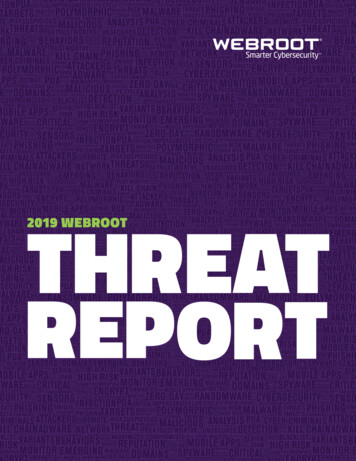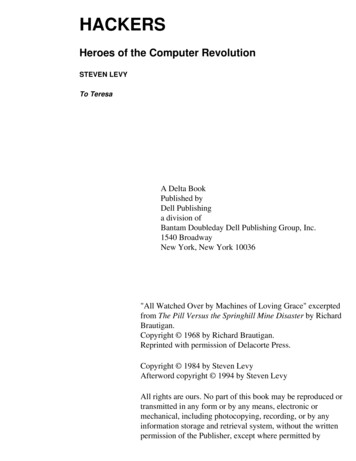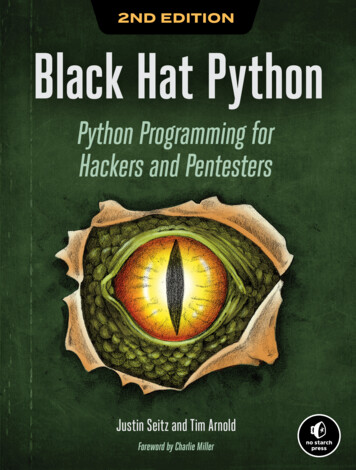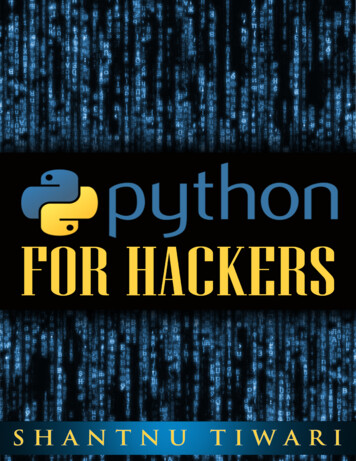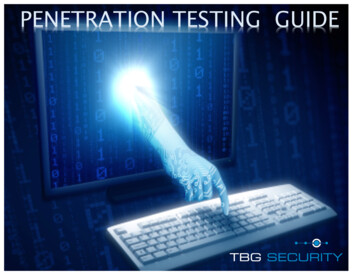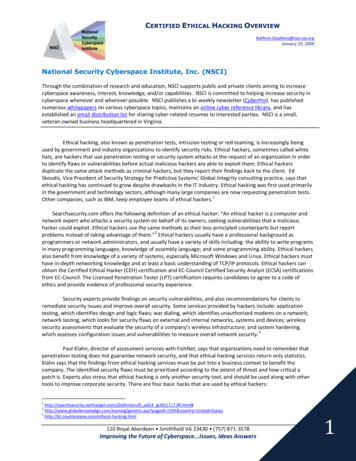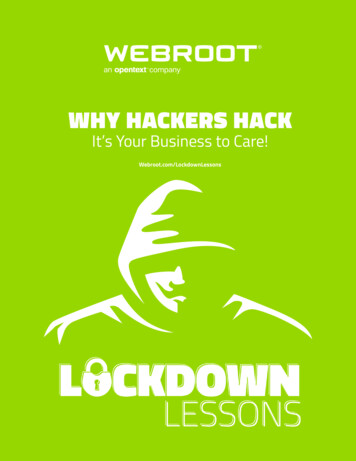
Transcription
WHY HACKERS HACKIt’s Your Business to Care!Webroot.com/LockdownLessons
INTRODUCTIONAs cybersecurity grows more complex, criminals around the world are evolving along with it. Theirmethods leave you vulnerable and many organizations are at risk. Staying informed on this ever-changinglandscape is vital. In this educational eBook, we explore the minds of hackers and open the window intotheir world. Learn why it’s important to debunk the common stereotypes, get informed on their methodsand motives, and find out who they target the most. IT security experts Tyler Moffitt, Kelvin Murray, andGrayson Milbourne offer help as you navigate today’s uncertain waters and lend tips on how to lock downyour business and protect your customers from ongoing threats.The Stereotype3What does a hacker look like? Stereotypes teach us to think of hackersonly as nefarious individuals who will stop at nothing to wreakunstoppable havoc, but this is far from reality. Discover the truth behindthe stereotypes and why you should care.The Profile5What are hackers after? Hackers typically fall into three distinctcategories: black hat, white hat, and grey hat. Their methods andmotives vary, from financial gain to disruption, and some even hack forthe fun of it. Learn why it matters for your business.Behind The HoodieWho do hackers target? Understanding why hackers are after yourbusiness and what methods they use to break into your systemscan help you stop attacks before they happen.7
THE STEREOTYPEWhen you think of a hacker, do you envision an anti-social, young hoodie-wearing man in a darkbasement? Popularized by Hollywood and mainstream media, this is the image many of us see, althoughit’s not entirely accurate. These stereotypes teach us to think of hackers only as nefarious individualswho will stop at nothing to wreak unstoppable havoc. However, the reality is that hacking is a variable,diverse, and highly indvidualized practice, and not all hackers are cybercriminals. In fact, some hackerscan even help strengthen your digital defenses!The History of the Hollywood HackerThe modern portrait of a hacker has been forged by popular films and television shows that perpetuate the myth of the young, reckless computergenius who can hack anything. The origins of this stereotype actually begin as early as the 1960s, with British comedy caper, The Italian Job.Thanks to the film’s success, the stereotype continued to evolve over the following decades until a more accurate portrayal appeared in 2015.The Italian Job (1969)FACT VS. FICTIONA robber gets help from a group of Britain’s most infamous computerhackers to steal gold bullion. This was one of the first Hollywooddepictions of hacking as a glamorous and profitable trade.Hollywood often portrays hackersas either righteous vigilantes orevil terrorists. This is a commonmisconception that romanticizeshacking while ignoring the realdangers; however, accuratedepictions can also cause realworld problems. For example, afterWarGames premiered in 1983,the U.S. government signed theComputer Fraud and Abuse Act todissuade hackers from replicatingattacks from the film.WarGames (1983)A high school student hacks into a military computer and accidentallyactivates the U.S. nuclear arsenal. One of the earliest films to envisionthe devastating global consequences of a single cyberattack.Hackers (1995)A teenage hacking group must prove that a sinister superhacker isframing them for embezzlement. Famously one of the first portrayals ofa female hacker, played by Angelina Jolie.The Matrix (1999)A computer hacker discovers that all life on earth may be nothing morethan an elaborate façade. This film helped popularize the fast-hacking“computer genius” stereotype we know today.Mr. Robot (2015)A young programmer works as a cybersecurity engineer by day and avigilante hacker by night. Considered to be one of the most accuratefictional portrayals of real-life hackers.While filmmakers and actors takeliberties with their depictions, the“Hollywood Hacker” stereotypeoffers a small glimpse into thereal motivations of hackers, likeespionage, theft, disruption, andeven altruism.3
Debunking the Hacker StereotypesHackers wear many hats and have diverse means and motives. One of the biggest hacker myths is that most hackers are computer geniuses,when in reality many hackers utilize lowcode software to write viruses or break into systems with little to no programming knowledge. Inactuality, not all hackers are out to ruin your business. Hacker motivations vary, from disruption to financial gain or just for the fun of it.MYTHTRUTHAll hackers are “bad guys”out to steal information.Computer hackers are individuals who usecomputers, networking, or other technology andskills to gain access to computer systems fordifferent reasons.All hackers are male.The average hacker is a male under age 35 buthackers can be any age, gender, or ethnicity.All hackers are lone wolves.Hackers are coordinated and work within abroad and complex network. They often havesalaries, set holidays, bonus payments andsales arrangements that include reseller portalsand component rental. It’s common for hackersto be involved in larger groups or organizations.Hackers have to work fast.Hackers usually aren’t concerned with a tickingclock, and many take a slow and methodicalapproach to get what they want.There’s very little money inhacking.The average cost of a data breach is 3.922million, and 71% of breaches are financiallymotivated. The average hacker can earn upto 40 times the median wage of a softwareengineer. 31Hackers only attack largecorporations.DID YOU KNOW?Cybercriminals useautomation to do thework of a full team ofhackers! AI-basedcyberattacks can strikemultiple businesses atonce, and no businessis too big or too smallto be a target.SMBs are prime targets. More than 70% of4cyberattacks target small businesses and MSPshold the keys when it comes to data access.By better understanding the true methods and motivations behind the myths,you can learn how to protect your business and customers against today’sbiggest threats.1, 3HackerOne. “The 2019 Hacker Report.” (August 2019)2Security Intelligence. “2019 Cost of a Data Breach Report.” (July 2019)4Verizon. “2019 Data Breach Investigations Report.” (May 2019)4
THE PROFILEHackers typically fall into three distinct categories: black hat, white hat, and grey hat. Black hats arehackers who violate computer security for malicious intent, while white hats test existing internetinfrastructures to find loopholes or bugs in the system, typically to improve security. Grey hats fallsomewhere in between, often breaking into systems illegally but without malicious intent. There are alsomany subtypes of black, white, and grey hat hackers with various means and motives, from the novicescript kiddie to the nation-state terrorist.Black, White, and Grey Hat HackersWhy do we categorize hackers by their “hats”? The analogy harkens back to the U.S. westerns of the 1930s and 40s, when the good guys wore whitecowboy hats and the villains donned black ones. While this is an oversimplification, the hat archetype helps us define different groups of hackers basedon their behavior and motivations.Black HatsAlso known as cybercriminals or threat actors, black hat hackers violatecomputer security with malicious intent or for personal gain. Talentedblack hats not only profit from targeting businesses and individuals, butalso from selling their tools to less technically capable hackers (“script kiddies”), such asransomware-as-a-service or exploit kits for hire. Black hats are generally highly skilled, butdon’t underestimate beginners. They can easily strike a big target with the right tools.White HatsAlso known as ethical hackers, white hats work to test existing internetinfrastructure to research loopholes or find bugs in a system. White hatshave historically been pivotal in ensuring that organizations maintain asecure network. They often work as employees or consultants, usually for governments andlarge corporations, although some partner with MSPs and security companies to help SMBs.5There are at least 300,000 registered white hat hackers around the world.Grey HatsGrey hat hackers are those whose hacking practices may violateethical standards but are generally performed without malicious intent.Similar to white hats, grey hats often hack into computer systemsto notify the administrator or owner that their network contains vulnerabilities, whichmust be fixed. However, unlike white hats, grey hat hackers may not work for an officialcompany and can choose to extort victims, offering to remove bugs for a nominal fee.5Security Intelligence. “2019 Cost of a Data Breach Report.” (July 2019)6PayScale. “Certified Ethical Hacker (CEH) Salary Data.” (December 2019)WHY DO THEY HACK?Financial gain is a primary driver forblack hat hackers, and hacking can behighly profitable. Black hats generallyearn money through theft, fraud,extortion, and other nefarious means.White hat motivations vary, althoughmoney and altruism top the list. Theaverage Certified Ethical Hacker earnsaround 91,000 per year.6 “Bug bounties”are one way for white hats to legally profitand gain recognition.Grey hats may be less malicious thantheir black hat counterparts, but moneyis still a major motivator, althoughsome hack for fun or to improve theirprogramming skills.5
Hacker SubtypesBetween the most altruistically motivated white hat to the deeply sinister black hat, there is a wide range of hacker personas, each guidedby the intentions behind their hacking. Understanding the hacker subtypes can help you identify potential threats as well as opportunities toleverage hacking to protect your business.Script KiddiesMost commonly associated with the “hacker in a hoodie” stereotype,Script Kiddies are programming novices who have some codingknowledge but lack expertise. They typically use free and open sourcesoftware, easily found on the dark web, to infiltrate networks, and canbe black, white, or grey hat.HacktivistsHacktivists are grey hat hackers with the primary goal of bringingpublic attention to a political or social matter through disruption. Twoof the most common hacktivist strategies are stealing and exposingsensitive information or launching a denial of service (DDoS) attack.One of the most well-known hacktivist groups is Anonymous, infamousfor taking down the CIA’s website.Red HatsRed hats are whiter shade of grey hats whose sole objective is to blockor destroy the efforts of black hat hackers. Considered the “vigilantes”of the hacker world, red hats will attempt to shut down maliciousattacks with their own tools rather than reporting the breach.“While this didn’tused to be the caseyears ago, most blackhats now are hackingfor monetary gainbecause there’s somuch money to bemade in hacking. Evenwhite hats who usetheir powers for goodcan make a profit.”— Tyler Moffitt, Senior Threat Research Analyst, WebrootNation-StateNation-state hackers are those who engage in espionage, socialengineering, or computer intrusion with the goal of acquiring classifiedinformation or seeking large ransoms. Backed by governments, theyare often sophisticated and well trained.Malicious InsidersAn insider may be a disgruntled current or former employee whosteals or destroys information, or someone hired by a competitor topilfer trade secrets. The most valuable data for a malicious insider isusernames and passwords, which can then be sold on the dark web toturn a hefty profit.Hackers can target any business for any reason! Understanding their methodsand motivations can help you keep your business and your customers safe.6
BEHIND THE HOODIEMost social stereotypes are easily debunked, and hoodie-clad hackers are no exception. Theaverage hacker comes in all shapes and sizes––often disguised as the boy or girl next door. Targetsof cybercrime are equally diverse. Many hackers will seek out low-hanging fruit, and the biggestvulnerabilities are often the result of human error. Weak passwords, lax email security, and out-of-datetechnologies are all easy wins for hackers, and no business or industry is truly safe. In fact, hackerscan specialize in breaching specific business types or industries, such as healthcare or finance, refiningtheir expertise with each new attack.Who They Breach: The Tricks of the TradeAlong the same lines as today’s hoodie stereotype, small and medium-sized businesses hold a dangerous misconception that hackers only targetlarge organizations, when in fact any business that handles personally identifiable information (PII), bank accounts, health data, and other sensitive information are vulnerable. The simple truth is, the majority of criminal money is being made from SMBs in key verticals. So who is a target?Managed Service ProvidersGovernment AgenciesMSPs hold plenty of valuable data for multiplecustomers across industries, which makes themprime targets. Island hopping is a common hackingtechnique wherein hackers jump from one businessto another via stolen login credentials. MSPs andtheir SMB customers are both potential targets ofthese attacks.Local and national governments are primarytargets for cybercriminals, particularly nationstate terrorists, for a variety of reasons. Smallgovernments and local agencies generate troves ofsensitive information, while large governments canbe victims of nation-wide disruption.Healthcare OrganizationsFinancial InstitutionsHospitals, physical therapy offices, pediatricians,chiropractors, and other healthcare practices areeasy targets for cybercrime due to their chaotic andsometimes lax security practices. Medical data andresearch is highly valuable to the right buyer. On thedark web, patient records alone can sell for up to 1,000 or more.7Banks, credit unions, and other financial institutionshave long been targets for hackers due to a wealthof data and money. In fact, in 2018, over 25% ofall malware attacks targeted banks––more thanany other industry. 8 What’s more, automation hasfurther enabled cybercriminals to run advancedattacks on financial institutions at scale.Municipalities, Infrastructure, andUtilitiesCelebrities, Politicians, and HighProfile BrandsCities can also fall victim to cyber attacks. Not onlyis the massive amount of data stored in city systemsattractive, hackers can also launch disruptiveransomware attacks, shutting down infrastructuresor utilities until they get paid. Many cities still relyon out-of-date legacy systems that are vulnerable tomalware or ransomware.7CBS News. “Hackers are stealing millions of medical records – and selling them on the dark web.” (February 2019)8Forrester. “The Total Economic Impact of the IntSights External Threat Protection Suite.” (October 2019)Hacktivists, who are politically, economically, orsocially-motivated, seek out celebrities, politicians,and other prominent organizations as targets. Theymay even attempt to embarrass public figures orbusinesses by stealing and disseminating sensitive,proprietary, or classified data to cause publicdisruption, or for private financial gain via blackmail.7
How To Protect Against Malicious HackersThe only prerequisite for becoming a target is having something that hackers want, which puts all businesses at risk. Luckily, threat awareness and aproactive approach to security can go a long way in keeping your business secure. While hackers have diverse means and motives, for black hats andother malicious meddlers your business holds the keys to the kingdom. It’s up to you to know their methods and to protect your business and yourcustomers from advanced threats.Think Like a HackerSecurity awareness is a vital component of effective cybersecurity. Infact, Webroot’s own research found that security awareness training9cut clicks on phishing links by 70% when delivered with regularity.Understanding hacker practices and motivations can help you predictpotential threats and thwart attacks more effectively.Lock Down Your Business FirstThe right security layers can protect you from threats on all sides.Check out more of Webroot’s free educational videos, podcasts, andcybersecurity guides in our Lockdown Lessons Resource Centerto discover how layered cybersecurity can benefit your business.“One of the biggesttrends we’ve seenover the last fewyears has been thespecialization ofcriminal hackers.”— Kelvin Murray, Senior Threat Researcher, WebrootLeverage Automated Threat DetectionAs modern attacks continue to increase in complexity and as attacksare automated at scale, your business will become more targeted. Thebest way to combat targeted attacks is to quickly and automaticallyremediate threats that do get through. Automated Detection andResponse (ADR) solutions improve the accuracy of detection andspeed of response, which are critical against attacks.Protect Your CustomersYour customers may be underequipped to handle a breach. MSPsare in a unique position to offer high-quality, comprehensive securityawareness training as well as cybersecurity expertise and automatedprotection for SMB customers. SMBs looking to strengthen theirsecurity posture should also look to partner with MSPs and othermanaged security providers to secure their own networks and systems.Understanding why hackers are after your business and what methods they useto break into your systems can help you stop attacks before they happen.9Webroot. “Webroot 2019 Threat Report.” (February 2019)8
CONCLUSIONAlthough hackers are diverse and hacking as a profession is more complex than many realize, the targetsof cyberattacks remain consistent: the reality is that every business is a potential target for malicioushacking — including you and your customers! Cyberattacks against MSPs and SMBs are on the rise,making it imperative to protect against all types of threats. Locking down your business starts with beingeducated about hackers and their methods, but it doesn’t stop there. Protect your customers with themost advanced cybersecurity solutions that can help close security gaps and quickly remediate threats.Don’t Wait to Protect Your BusinessWhat you don’t know can hurt you! Start a free Webroot trial and see for yourself how our solutions canhelp you prevent threats and maximize growth.Start My Free TrialAbout WebrootWebroot, an OpenText company, harnesses the cloud and artificial intelligence to protect businesses and individualsagainst cyber threats. We provide endpoint protection, network protection, and security awareness training solutionspurpose built for managed service providers and small businesses. Webroot BrightCloud Threat Intelligence Servicesare used by market leading companies like Cisco, F5 Networks, Citrix, Aruba, A10 Networks, and more. Leveraging thepower of machine learning to protect millions of businesses and individuals, Webroot secures the connected world.Webroot operates globally across North America, Europe, Australia and Asia. Discover Smarter Cybersecurity solutionsat webroot.com.Check out our Lockdown Lessons podcast series, guides, and other resources to help MSPs and businesses navigatetoday’s cyber threat landscape and be their most successful.Visit webroot.com/LockdownLessons 2020 Webroot Inc. All rights reserved. Webroot, BrightCloud, and Smarter Cybersecurity are trademarks or registered trademarks of Webroot Inc. in the United States and/orother countries. All other trademarks are the properties of their respective owners.
WHY DO THEY HACK? Financial gain is a primary driver for black hat hackers, and hacking can be highly profitable. Black hats generally earn money through theft, fraud, extortion, and other nefarious means. White hat motivations vary, although money and altruism top the list. The averag

